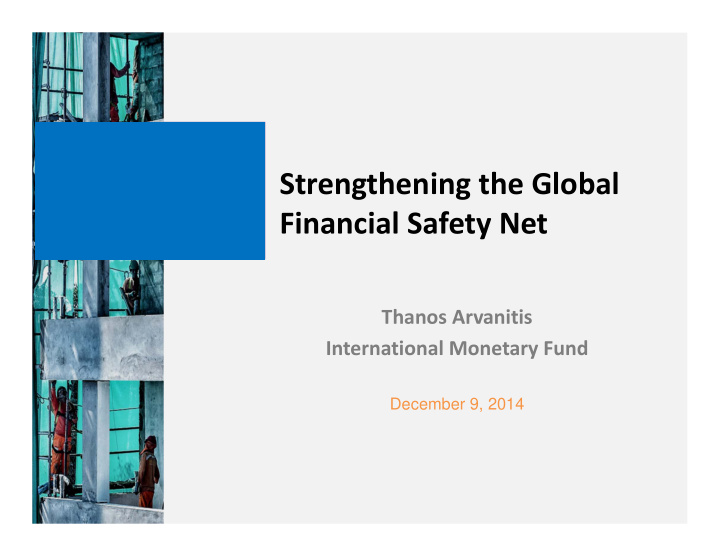



Strengthening the Global Financial Safety Net Thanos Arvanitis International Monetary Fund December 9, 2014
Systemic crises are not rare FSI for stressed economies (RHS) 20 25 Advanced economies Global financial Russian default and LTCM crisis Emerging markets collapse Nikkei crash, DBL 20 bankruptcy, and 15 Scandinavian banking crisis October 1987 stock ERM 15 market crash crisis 10 Dot-com Asian US crash crisis 10 banking Argentine stress default / US Tequila corporate crisis 5 crisis 5 0 0 1981 1984 1987 1990 1993 1996 1999 2002 2005 2008
Capital flow volatility continues to pose risks to EM economies Gross Capital Flows to EMs (In billions of USD) 1800 Other Inflows 1600 Portfolio Inflows 1400 Direct Inflows 1200 Gross Total Inflows 1000 800 600 400 200 0 ‐ 200 2000 2002 2004 2006 2008 2010 2012 Source: FFA and IMF staff calculations.
Potential for global spillovers has increased Increased co ‐ movement in asset prices Increased liquidity risks Correlation between EM and AM EM local government bonds asset prices (linear trend) (USD, billion) 600 0.8 Bond yield Equity return 0.7 500 0.6 Nonresident 400 holdings 0.5 300 0.4 0.3 200 0.2 Daily trading 100 volume 0.1 0 0 1998 2000 2002 2004 2006 2008 2010 2012 2014 2007 2008 2009 2010 2011 2012 2013 Sources: IMF Global Financial Stability Report, Fall 2014 and Fund staff calculations.. 19
A multi ‐ layered global safety net has emerged Self ‐ insurance – Reserve accumulation Bilateral Bilateral swap lines – Regional RFAs and BRICS CRA – Global IMF and other IFIs – There are important synergies across these four layers, but fragmentation has also increased
Self insurance Accumulation of FX Reserves Sizable increase in reserves (Bil of USD) 12000 Reserves can bring important Emerging market economies 10000 benefits in terms of mitigating crises Advanced economies 8000 But can also result in inefficiencies 6000 – Holding excessive reserves can be costly 4000 – Potential market distortions (excess demand for safe assets) 2000 – They may never be enough (race to the top) 0 2000 2002 2004 2006 2008 2010 2012 Source: IFS and IMF staff calculations.
Bilateral Swaps Potential for unconstrained supply Provision of FX liquidity, with limited/or no stigma Uncertain availability (concerns about credit risk and consistency with central bank mandate) Subject to national preferences/interests 7
Regional Financing Arrangements (Most) relatively limited in size Unconditional support? How to deal with credit risk – Some rely on IMF programs/endorsement Governance Less stigma? 8
RFAs have expanded since the global financial crisis ESM $685B BRICS 1/ $100B AMF CMIM 1/ $2.7B FLAR $240B 2/ $2.3B 1/ China participates in both of BRICS and CMIM 2/ The Eurasian Economic Community Anti ‐ crisis Fund (ACF) has contributions of $8.5 billion.
Size of RFAs varies Size of RFA Relative to Region's 2013 GDP (In percent) 6 5.31 5 4 3 2 1.31 1 0.62 0.22 0.10 0 AMF BRICS FLAR ESM CMIM Source: RFA websites and IMF staff calculations.
IMF reforms were a central part of the response to strengthening the GFSN Quadrupled resources Two new instruments (FCL and PLL) Enhanced flexibility of existing instruments Still relatively limited demand for precautionary instruments • Stigma limits role played by the Fund Duration/exit issues for FCLs? •
Options to strengthen the GFSN —Many proposals but still many questions How to prevent fragmentation? Cooperation between/with RFAs – How to strengthen coordination? Co ‐ financing? – G ‐ 20 Principles for Cooperation between the IMF and RFAs Support for central bank swap lines Options to enhance the use of Fund instruments
Thank you
Recommend
More recommend